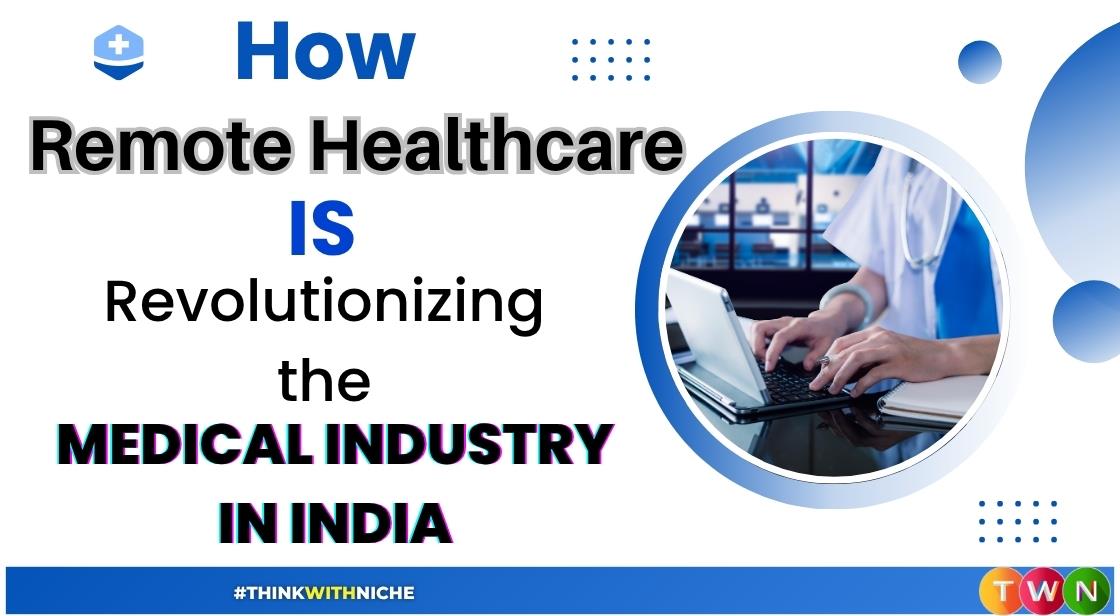How Remote Healthcare Is Revolutionizing the Medical Industry in India

Blog Post
The rise of remote healthcare, especially telehealth and telemedicine, has transformed the medical industry in India, offering a scalable solution to the long-standing challenges of healthcare access, affordability, and quality. Accelerated by the COVID-19 pandemic, telemedicine has evolved into a vital component of the healthcare ecosystem, bridging the rural-urban divide and empowering underserved communities.
According to the Ministry of Health and Family Welfare, India’s flagship telemedicine platform eSanjeevani has recorded over 34 crore consultations as of early 2025, making it one of the world’s largest digital health platforms.
With over 1.2 billion mobile subscribers and more than 850 million internet users, India is uniquely positioned to lead the global telehealth revolution. The government’s Ayushman Bharat Digital Health Mission (ABDM) further solidifies this digital transformation by integrating health records and enabling citizens to securely share their medical data through unique Ayushman Bharat Health Account (ABHA) IDs.
Moreover, initiatives like the National Tele Mental Health Programme and e-Vidya Bharati & e-Arogya Bharati (e-VBAB) are reshaping mental healthcare access and international tele-education in health sciences, respectively. India's telehealth sector is now valued at $1.54 billion in 2024, and is projected to grow at a CAGR of over 20% till 2030, reflecting increasing investor interest and technological innovation.
In this blog post, we delve into how remote healthcare is revolutionizing patient care, improving public health outcomes, enabling digital inclusion, and creating new opportunities for both patients and stakeholders in India's rapidly evolving healthcare landscape.
How Telehealth Is Redefining the Future of Healthcare Delivery
The Dawn of a New Healthcare Era
The global healthcare landscape has undergone a profound transformation, significantly accelerated by the COVID-19 pandemic. At the forefront of this revolution is telehealth, a paradigm shift that has made medical consultations and treatments accessible across geographical boundaries. In India, this transformation has been particularly impactful, not only bridging critical geographical gaps but also empowering rural communities and individuals with mobility limitations.
Telehealth has unlocked unprecedented opportunities for enhanced patient engagement and cost-effective care delivery, fundamentally democratizing healthcare nationwide. Having established a robust foundation, its exponential growth is poised to continue, inspiring immense hope for the future of healthcare in India.
Understanding Telehealth: A Comprehensive Overview
Telehealth generally encompasses the provision and coordination of healthcare and related services using telecommunications and digital communication technologies.
This expansive concept encompasses various forms of remote care, including:
-
Medical Consultations, Diagnosis, and Treatment: Facilitating virtual doctor visits, enabling remote diagnoses, and guiding treatment plans.
-
Patient and Provider Education: Delivering health information and educational content remotely.
-
Health Information Services: Providing access to health-related data and resources.
-
Self-Care Support: Empowering patients to manage their health effectively.
Telehealth integrates several key components:
-
Telemedicine: Telemedicine, an essential component of telehealth, refers specifically to the delivery of clinical services at a distance. This includes virtual consultations, diagnosis, treatment, and follow-ups conducted between healthcare providers and patients.
-
Mobile Health (mHealth): Healthcare practices supported by mobile devices, such as smartphones, tablets, and wearables, for monitoring, data collection, and communication.
-
Remote Patient Monitoring (RPM): The use of technology to monitor patient health data outside traditional clinical settings, often employing wearable devices or home monitoring kits.
-
AI-Driven Virtual Healthcare Solutions: Leveraging artificial intelligence for tasks like preliminary diagnoses, personalized health recommendations, and intelligent chatbots for patient queries.
These services are enabled via synchronous methods (real-time interactions like audio and video calls) and asynchronous methods (store-and-forward communication like text-based messages and image sharing), ensuring accessible and efficient remote care.
While "telehealth" is the broader term, "telemedicine" primarily focuses on virtual consultations and treatment, whereas telehealth integrates a wider array of technology-driven solutions for holistic healthcare access, monitoring, education, and management.
Both are indispensable in expanding healthcare services, particularly in remote and underserved regions, thereby narrowing the healthcare accessibility gap in India and globally.
In India, a diverse ecosystem of telemedicine platforms has emerged. Prominent examples include Practo, Mfine, and Tata Health, which offer online doctor consultation services. Similarly, Apollo TeleHealth specializes in remote diagnostic and specialty care.
Government Initiatives Paving the Way for Remote Healthcare
The Indian government has been a proactive champion of digital health, recognizing its potential to transform the healthcare system.
Policy Frameworks and Guidelines:
-
NITI Aayog’s Telemedicine Guidelines: This crucial framework provides legal and ethical guidance for teleconsultations across the country, ensuring patient safety and data privacy.
-
India’s Digital Health Policy: This policy strongly advocates for the integration of digital tools to enhance the efficiency and outcomes of the healthcare system. It places significant emphasis on utilizing telemedicine services, especially within Health and Wellness Centres (HWCs) at the grassroots level. Here, mid-level providers or health workers can connect patients with doctors via technology platforms, facilitating timely and optimal care.
Flagship Digital Health Programs:
Government-led telehealth programs have significantly influenced the healthcare sector, providing vital support to patients across urban areas and, more importantly, reaching underserved rural and remote regions of the country.
National Tele Mental Health Programme (Tele-MANAS):
Launched in October 2022, this program offers remote mental healthcare services. As of April 1, 2025, the program operates 53 Tele-MANAS cells across 36 States/UTs, having handled over 20.05 lakh calls on its toll-free numbers (14416 and 1-800-891-4416). It provides multi-language support, proving pivotal in connecting callers with mental health professionals.
India's national telemedicine service, eSanjeevani, provides quick and easy remote access to doctors and medical specialists. Since its inception in 2020, it has served an astounding over 36 crore patients through teleconsultations as of April 6, 2025, with 232,291 providers onboarded. Operating on a hub-and-spoke model, patients can access eSanjeevani through the 1,76,573 Ayushman Arogya Mandirs (formerly known as Health & Wellness Centres) operational until February 2025, or via its online outpatient department (OPD) module. This platform has significantly narrowed the healthcare gap, enhancing the quality of life for millions in rural India and even stimulating rural economic development.
Ayushman Bharat Digital Mission (ABDM):
This ambitious digital healthcare initiative aims to integrate telemedicine, Electronic Health Records (EHR), and comprehensive health data management. As of April 2025, over 380 million Ayushman Bharat Health Accounts (ABHA) have been created, with more than 262 million health records linked, streamlining healthcare delivery and access to medical history.
Other Supporting Initiatives:
-
The National Health Portal aims to enhance health awareness and expand access to healthcare across the country by offering affordable, health-related information in various regional languages through a centralized platform.
-
Pradhan Mantri Surakshit Matritva Abhiyan (PMSMA): Managed through a dedicated portal, dashboard, and helpdesk by the Centre for Health Informatics (CHI), PMSMA aims to ensure comprehensive and high-quality treatment for pregnant women across the nation. Since its launch in November 2016, it has served 4,73,46,865 women through 20,752 facilities, providing free, high-quality prenatal care.
Remote Healthcare: Transforming Patient Care and Addressing Inequities
One of India's most significant healthcare challenges remains the uneven distribution of healthcare infrastructure. Rural hospitals account for only "36-37% of total beds," while urban hospitals hold the remaining "63-64%." Although the numbers of hospitals, beds, and other amenities have steadily increased, as confirmed by the National Health Profiles of 2022 and 2023, this disparity persists.
This is where telehealth has proven to be a game-changer, effectively bridging the gap to provide world-class patient care to a majority of India's rural population, who traditionally face limited access.
The government's unwavering commitment to providing equitable access to quality care for all is underscored by its emphasis on digital health as a critical enabler for systemic transformation.
Mainstreaming telemedicine within health systems will significantly minimize inequity and barriers to access. India's digital health policy champions the use of digital tools to enhance the efficiency and outcomes of the healthcare system, with a particular focus on integrating telemedicine services into Health and Wellness Centres at the grassroots level.
This allows mid-level providers or health workers to connect patients with doctors via technology platforms, ensuring timely and optimal care.
Joint initiatives by the Government of India and private stakeholders—including social enterprises and public-private partnerships—are driving efforts to enhance healthcare affordability and accessibility in rural regions. A growing number of e-clinics equipped with advanced information and communication technologies (ICT) are being set up, many with official accreditation from relevant ministries.
A leading example of this progress is India’s national telemedicine platform, eSanjeevani, which has significantly improved access to remote medical consultations with doctors and specialists.
Telemedicine: A Catalyst for Enhanced Healthcare Accessibility
Telemedicine is particularly well-equipped to meet the varied and frequently complex healthcare demands of rural India. Primary care doctors and frontline health workers usually act as the initial touchpoint for medical services, offering diagnosis and treatment for a wide range of illnesses and injuries, overseeing chronic disease management, and encouraging preventive healthcare practices.
Telemedicine plays a constructive role in supporting these functions, thereby reducing the burden on the overall healthcare system.
With **over "1.17 billion" telecom subscribers as of April 2025, and 232,291 providers onboarded on eSanjeevani as of April 6, 2025, rural healthcare is undergoing rapid transformation, bringing India closer to its vision of healthcare for all.
The demographic data from eSanjeevani consultations further highlights its impact: more than "57%" of beneficiaries are women and approximately "12%" are senior citizens, underscoring telemedicine's crucial role in understanding and meeting the unique healthcare needs of rural India's diverse population.
Investment Opportunities in India's Telehealth Sector
The swift integration of telemedicine and other digital tools to address healthcare delivery challenges in India’s rural and remote regions—alongside their use in areas such as education, training, and administration—offers a promising investment opportunity for forward-thinking investors in a rapidly evolving sector.
India’s telehealth industry was estimated to be worth around USD 3.10 billion in 2024 and is expected to grow significantly, reaching approximately USD 19.90 billion by 2033. This impressive expansion reflects a strong compound annual growth rate (CAGR) of 20.50% between 2025 and 2033.
Numerous promising investment avenues are emerging within the telehealth ecosystem, particularly in the following areas:
-
Wearable Device Development and Manufacturing: Focused on enabling remote patient monitoring and real-time health data collection.
-
Consumer-Focused Mobile Health Applications: Designed to support virtual doctor consultations, medication scheduling, and personal health tracking.
-
Developing Software and Technologies for AI: For diagnostics, predictive analytics, and personalized medicine.
-
Surgical Robotics and Sensors: Enhancing precision and remote surgical capabilities.
-
Remote Diagnostics and Electronic Health Records (EHR) Systems: Streamlining data management and diagnostic processes.
-
Monitoring Systems: For continuous patient oversight.
-
Healthcare SaaS Solutions: Healthcare SaaS Solutions are transforming the digital health landscape by integrating services such as e-pharmacies and remote patient monitoring (RPM) applications. These platforms enable virtual medical consultations, issue digital prescriptions, collect real-time patient health data from connected medical devices, and facilitate secure communication among pharmacists, patients, and healthcare professionals. The global RPM market is also witnessing robust expansion, with projections indicating a CAGR of 12.7%, expected to reach $56.94 billion by 2030.
Furthermore, government initiatives encourage investment through various incentives. All healthcare education and training services are exempt from service tax. Healthcare services like telemedicine and remote radiology can receive a "250% tax deduction" for approved operating technology expenditures. Domestically manufactured medical technology items are also eligible for an income tax exemption for "15 years."
Complementing domestic efforts, India has invested "₹105.9 crore" till November 2024 on the 'e-Vidya Bharati and E-Arogya Bharati (e-VBAB)' tele-education and tele-medicine project. Initiated in October 2019, this program delivers services across 22 African nations, such as Benin, Guinea, Zambia, Malawi, Ghana, Congo, Sudan, Somalia, and Nigeria. In addition, it offers 50,000 scholarships to African students, with 15,000 of these scholarships facilitated through online platforms.
Benefits of Telehealth Services for Patients
Telehealth serves as a highly practical solution for individuals who are unable or reluctant to travel—such as elderly patients, expectant mothers, or people with disabilities—and is especially useful for managing medical conditions that do not require in-person lab tests or physical examinations. Additional key advantages include:
-
Easy Access: Especially for people living in rural and remote areas.
-
Reduced Overhead Costs: For both patients (travel, time off work) and healthcare providers.
-
Less Chance of Infection: Minimizing exposure to contagious diseases in clinical settings.
-
Enhanced Continuity of Care: Facilitating regular follow-ups and chronic disease management.
Capitalizing on the Growth of Telehealth: A Collaborative Future
Telehealth has significantly enhanced efficiency, reduced costs, and narrowed the healthcare access gap between rural and urban regions in India. The National Health Authority (NHA), established in January 2019, plays a key role as a statutory body in advancing e-health practices. It oversees the development and enforcement of standards related to electronic health data, including privacy, security, storage, and exchange protocols.
The NHA introduced the Health Data Management Policy, which outlines essential privacy safeguards—such as consent procedures, rights to access and delete health records, and rules for data collection, usage, and storage. Additionally, an electronic consent management framework has been implemented to securely capture and maintain verifiable user consent records.
The Ayushman Bharat Digital Health Mission (ABDM) has further enhanced transparency and reliability by integrating digital identity services. The Ayushman Bharat Health Account (ABHA) is a unique identifier that empowers Indian citizens to securely save and exchange medical information with doctors, hospitals, and laboratories.
With pioneering programs addressing crucial challenges on a large scale, India stands at the forefront of the global digital health transition. As a key supporter of the WHO’s Global Initiative on Digital Health (GIDH), which was launched during India’s G20 Presidency in August 2023, India has emerged as a global leader in fostering collaboration, interoperability, and equitable access to digital health solutions.
This strategic positioning offers global investors a unique opportunity to make a lasting impact on India’s healthcare sector by solving unique challenges through innovation and technology, ultimately making healthcare more accessible, affordable, and equitable for all. While unique challenges may arise, they often present stepping stones to significant opportunities for global investors in this rapidly evolving telehealth sector.
Future Outlook
Telehealth in India is poised for rapid growth, driven by rising connectivity, AI adoption, and supportive policy. Innovations in AI diagnostics, virtual training, and remote surgery are on the horizon. Global and domestic investment is surging, and the synergy between telehealth and digital infrastructure promises a more accessible, equitable, and efficient healthcare system.
Conclusion
Remote healthcare marks a pivotal shift in India’s medical landscape, closing rural–urban gaps and improving health outcomes nationwide. With government endorsement, booming private platforms, and robust investor interest, telehealth is on track to redefine medical accessibility. By addressing challenges like digital equity, privacy, and interoperability, India can lead the global healthcare revolution—bringing quality care to every corner of the nation.
You May Like
EDITOR’S CHOICE












